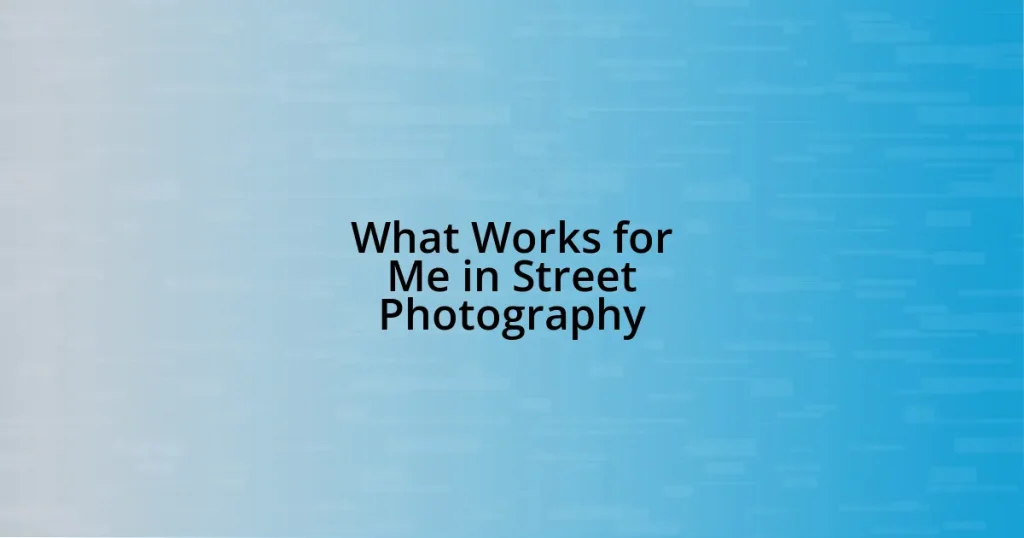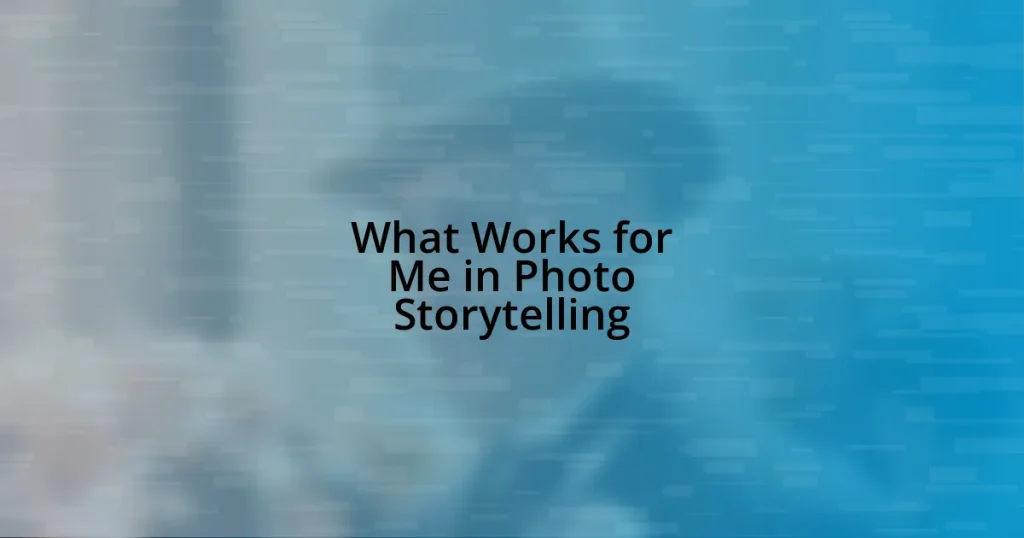Key takeaways:
- Effective visual storytelling emphasizes composition, lighting, color palette, and emotional authenticity to engage viewers deeply.
- Utilizing techniques like visual metaphors, juxtaposition, and pacing can enhance narrative depth and allow for varied interpretations.
- Imagery serves as a powerful tool for fostering cultural understanding and empathy, showcasing shared human experiences across diverse backgrounds.
- Analyzing successful visual campaigns reveals the importance of authenticity, personalization, and community engagement in creating impactful narratives.

Understanding storytelling through images
Understanding storytelling through images is a fascinating journey I’ve come to appreciate over the years. I remember flipping through an old photo album with my grandmother, where each image sparked tales of love, loss, and laughter. Have you ever felt that rush of nostalgia when a single photograph takes you back to a moment in time? That’s the power images hold—they evoke emotions and create connections beyond the mere visual.
With each snapshot, there’s a story waiting to unfold. For instance, I often look at landscape photography and wonder about the lives behind those serene vistas. Who has stood in that very spot, what were their thoughts and emotions? These questions highlight how an image can serve as a portal to different experiences and perspectives, inviting viewers to dive deeper into the narrative.
But it’s interesting how two people can perceive the same image in entirely different ways. I once shared a travel photo with friends, and while some felt excitement and wanderlust, others expressed a sense of loneliness. Isn’t it compelling how storytelling through images can evoke such varied emotions? This diversity in interpretation enriches the story, drawing us into a world brimming with personal connections and shared humanity.
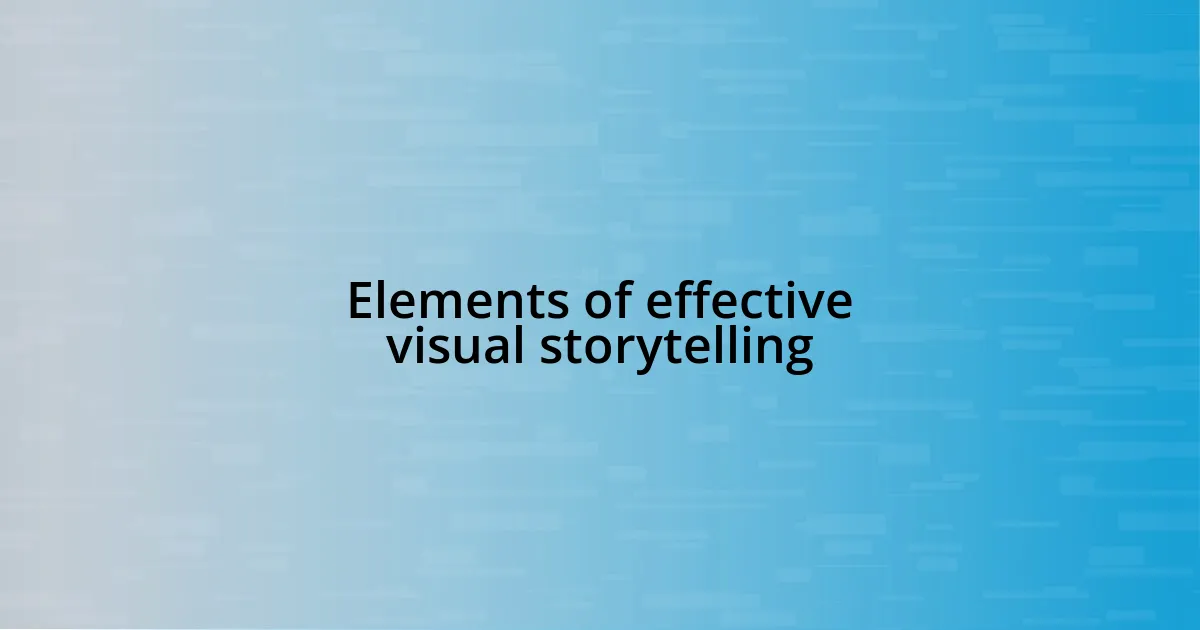
Elements of effective visual storytelling
One key element of effective visual storytelling is composition. The arrangement of elements within a frame can dramatically influence the narrative. I remember experimenting with angles while photographing a friend’s wedding; by focusing on the candid moments between guests instead of the posed shots, I captured genuine emotions—a fleeting smile, a tear of joy—that told a deeper story than any staged photo could. This taught me how crucial thoughtful composition is in guiding the viewer’s eye and conveying emotion clearly.
Here are some essential elements to consider for impactful visual storytelling:
- Lighting: Natural light often imbues images with warmth, while shadows can create drama.
- Color Palette: Colors evoke emotions; vibrant hues can energize while muted tones can suggest melancholy.
- Subject Matters: The choice of subjects shapes the story; a child playing evokes innocence, while a weathered face speaks to experience.
- Context: Providing background elements helps situate the viewer; a photo of an empty bench in a bustling park can tell a tale of solitude.
- Emotion: Capturing candid reactions often resonates more profoundly than posed expressions, forging a relatable connection with the audience.

Techniques for compelling image narratives
When I think about techniques for compelling image narratives, one stands out prominently: the use of visual metaphors. I recall shooting a series of images depicting seasons changing—bare trees in the cold depths of winter transitioning to vibrant blooms in spring. Each image told the story of resilience and renewal. It made me realize how powerful symbolism can be; it adds layers of meaning and invites viewers to interpret the narrative in their own unique ways.
Another technique I often employ is the element of juxtaposition. My experience with contrasting images, such as one of a cheerful child playing and another of a solemn elderly person watching, creates a striking narrative dynamic. This contrast provokes thought, encouraging viewers to reflect on the joys and sorrows of life. How often do we notice these contrasts in everyday life, and how can we capture them to deepen our storytelling?
Lastly, pacing plays a crucial role in visual narratives. I once created a photo series intentionally set at different times of day, capturing the same location under varying light. By arranging images in a sequence that mirrored a day’s progression, I found that viewers could almost feel the time passing. It reminded me that storytelling isn’t just about what is shown but also how the images flow together to create an emotional experience.
| Technique | Description |
|---|---|
| Visual Metaphors | Using symbols within images to convey deeper meanings and invite personal interpretation. |
| Juxtaposition | Contrasting elements to provoke thought and highlight different facets of narratives. |
| Pacing | Arranging images in a sequence to guide the viewer through an emotional journey or story. |
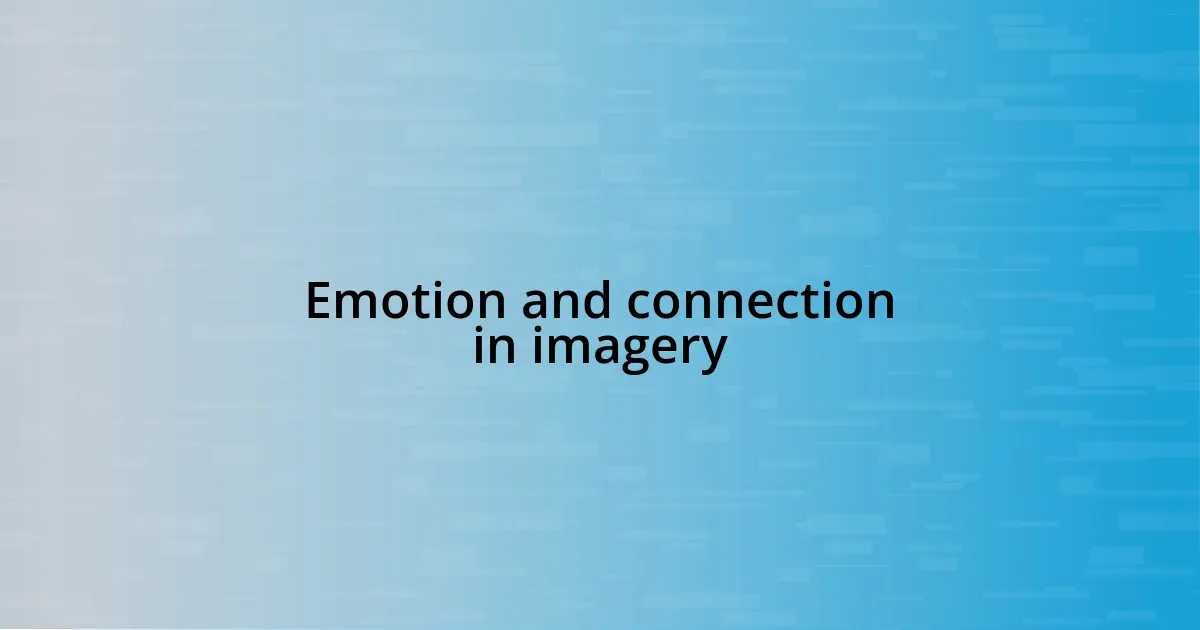
Emotion and connection in imagery
Imagery has a unique power to evoke emotions, often transcending words. Recently, I attended a photography exhibition that showcased portraits of individuals from diverse backgrounds. Each face told a story—eyes shimmering with joy or shadows of sorrow—drawing me in and prompting me to reflect on my own emotions. Have you ever looked into a photograph and felt an instant connection to the subject? That shared human experience is what makes imagery so profound.
I remember shooting a rainy day from my window; the droplets streaming down created a smudgy, dreamlike quality. In that moment, I realized how the elements of nature could mirror our own feelings. The melancholy of the rain reflected my mood perfectly, and I captured it hoping to convey a sense of nostalgia. It made me think: how often do we forget the impact of such small moments in our lives? They can hold immense emotional weight and allow viewers to see a part of themselves in our imagery.
When I look at my past work, I notice that the images that resonate most deeply often feature candid moments. I once photographed a couple during their engagement, and the laughter shared between them felt so real that it almost moved me to tears. That emotional authenticity creates a bridge with the audience, inviting them into the narrative in a way that staged shots can’t. Why do you think candid moments touch us so deeply? I believe it’s because they capture the raw essence of connection and vulnerability, revealing the shared humanity that binds us all.
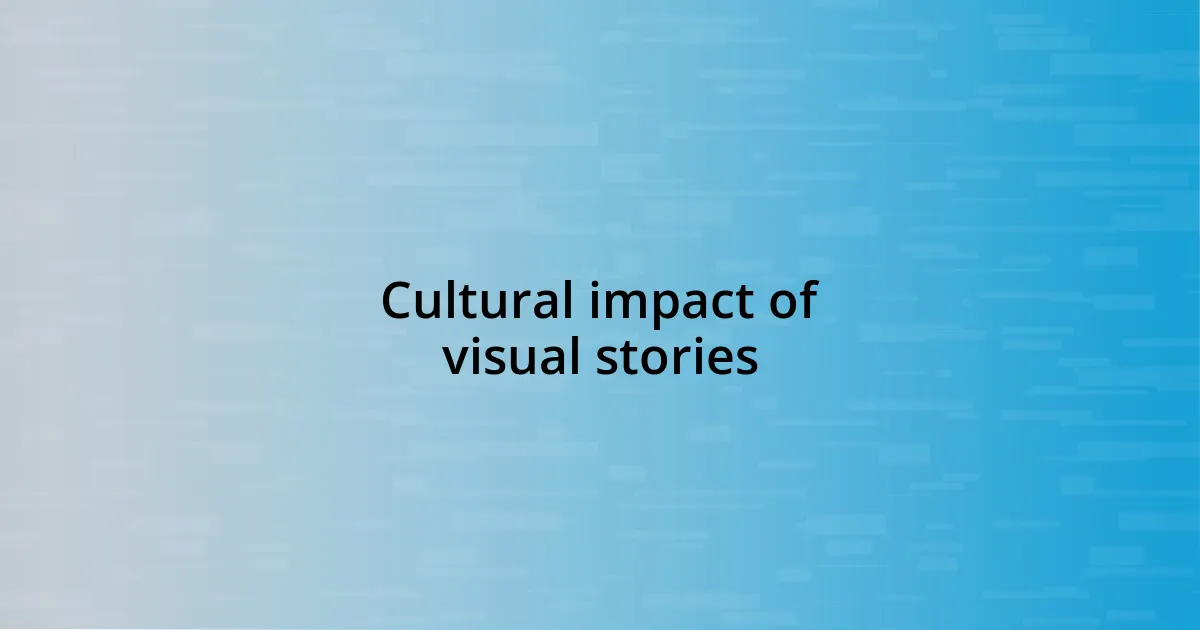
Cultural impact of visual stories
Visual storytelling holds immense power in shaping cultural perceptions. I vividly remember attending a community art project where local photographers captured images reflecting their cultural heritage. Each photograph was more than just a visual; it painted a vivid narrative of traditions, customs, and shared experiences. Isn’t it fascinating how a single image can preserve and communicate a piece of history, fostering a sense of belonging in the viewers?
When I think about the role of visual stories in shaping societal norms, I can’t help but reflect on the impact of documentary photography. I stumbled upon a photo series documenting the lives of refugee families. The images conveyed strength and resilience while challenging stereotypes. It made me think: how can we break down barriers and foster empathy through authenticity? These visual narratives not only educate but also inspire action, encouraging viewers to engage with issues from a personal perspective.
Cultural visuals also enrich our understanding of diversity. Recently, I found myself immersed in a vibrant exhibit showcasing the different celebrations around the world. The photographs captured not just visual aesthetics but the spirit of human connection inherent in each celebration. It struck me that these moments resonate universally, allowing us to appreciate our differences while also recognizing our shared humanity. How often do we let visual narratives expand our worldview? They remind me of the beauty of cultural exchange, inviting a dialogue that transcends borders.

Tips for creating impactful images
To create impactful images, consider focusing on your subject’s emotions—it’s what makes an image resonate. Recently, I experimented with the contrast of light and shadow while shooting a portrait of my friend. The soft light highlighted her eyes and brought an unexpected depth to her smile, capturing a moment that felt alive. Have you ever paused to notice how lighting can completely change the mood of a photograph? It’s fascinating how a simple adjustment can turn an ordinary shot into something extraordinary.
Another tip is to think about the composition of your images. I once learned the power of framing when I captured a sunset between two trees during a hike. By positioning the branches to guide the viewer’s eye, I created a natural frame that emphasized the vibrant colors of the sky. This made me realize that a well-composed image invites the viewer into the scene rather than just showing them a subject. What if you considered how your surroundings can enhance your story? The environment can add layers of meaning to your photographs.
Lastly, don’t shy away from incorporating personal stories in your imagery. I remember documenting a day in the life of my grandmother, who had an incredible collection of heirlooms. Each object she shared had a story, and my images captured more than just items; they revealed her legacy and the warmth of our family history. How often do you reflect on the narratives that shape your life? Images carry those stories, and by sharing your experiences, you invite others to see snippets of their own lives reflected back at them, making your images not just visuals, but visual memoirs.

Analyzing successful visual campaigns
Analyzing successful visual campaigns requires a keen understanding of the message being conveyed. One campaign that comes to mind is Dove’s “Real Beauty” initiative. They showcased real women of different shapes, sizes, and ethnic backgrounds in their ads, encouraging a dialogue about self-acceptance. This approach touched me deeply as it dared to challenge conventional beauty standards while resonating with countless individuals. Don’t you find it refreshing when brands embrace authenticity over the unrealistic portrayals so prevalent in media?
Another standout for me is the “Ice Bucket Challenge” campaign aimed at raising awareness for ALS. This initiative utilized user-generated content effectively, with participants sharing videos of themselves taking the plunge for a cause. I vividly recall the whirlwind of laughter and joy on my social media feeds, which fostered a sense of community around a serious issue. How powerful is it that a simple act of fun could inspire so many to contribute to substantial fundraising efforts? It’s a perfect example of how engaging visuals can drive meaningful action.
Lastly, the “Share a Coke” campaign really caught my attention due to its personal touch. By replacing the iconic logo with popular names, Coca-Cola transformed the experience of buying a drink into a quest for connection. I remember the excitement of finding a Coke bottle with my name on it, which made me feel special in a way I hadn’t expected. Isn’t it interesting how personalization in visual campaigns can create a lasting emotional impact? These experiences illustrate how powerful imagery, when combined with relatability, can elevate a campaign to remarkable success.















